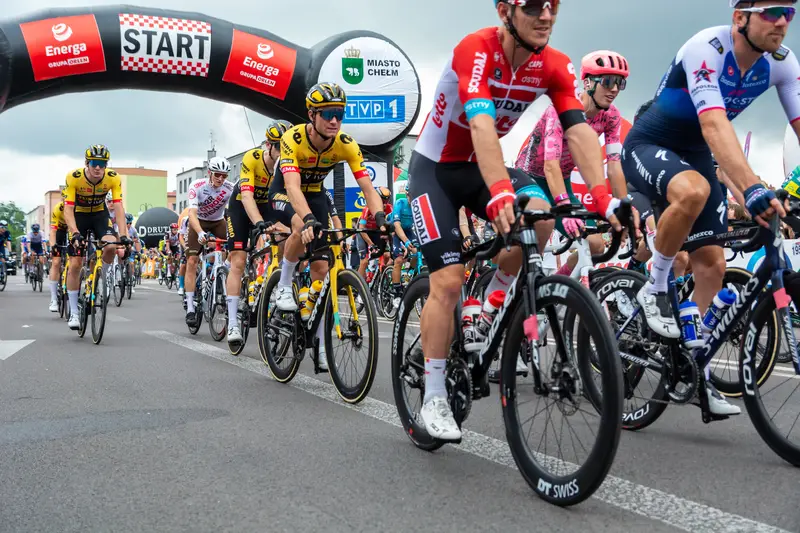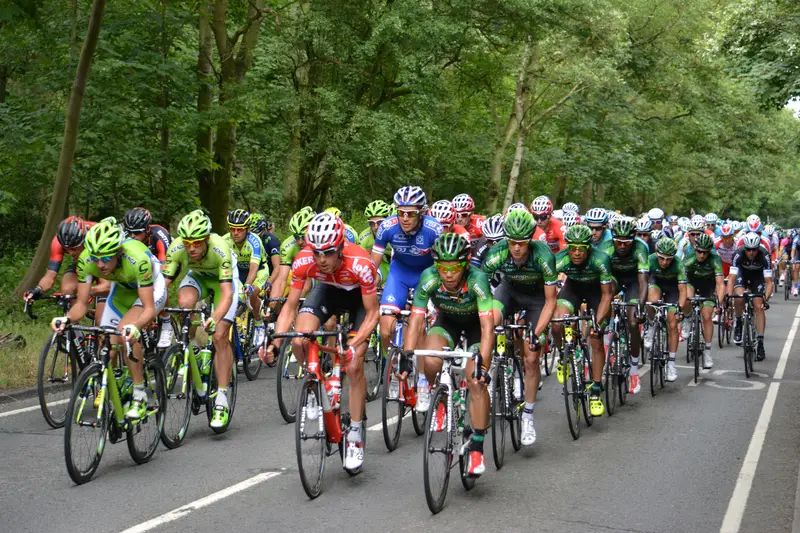
We often hear the phrase ‘peloton’ uttered throughout cycling races around the world, but do you know what the peloton really is? If not, you’re in luck because today we’ll go through everything you need to know about the peloton.
We’ll be looking at various topics relating to the peloton such as who is part of it, why it’s important, and whether you have to be a part of it. Let’s go!
The peloton is a general term for the main bunch in a cycling race. The peloton contains riders from each team and is there to provide structure during a race. Riders can race outside of the peloton, either up the road in a breakaway or further behind after being dropped.
Who Is a Part of The Peloton?
In a way, every professional cyclist in the world is a part of the peloton as the phrase is often used as a way to describe the group of professionals that race.
From a more nuanced approach though, the peloton is merely the ‘main bunch’ in a race that has most of the riders competing within it.
The peloton is made up of riders from every team that competes in a race and can range in size depending on which event is taking place. For example, the peloton at the Tour de France is much larger on than at a small one-day race in the Netherlands.
Each rider in the peloton has a different specialty, with some having the specific job of keeping the bunch under control during a stage (we will return to this point later).
Within the peloton, there are sprinters, climbers, TT specialists, GC riders, and more which can often lead to chaos ensuing at points in certain races.
In terms of individual importance, there are riders that take on the role of ‘road captains’ during races. These riders are essentially in command of their team, much like soccer captains are in that sport.
The role of the road captain is to keep the team under control and to provide some level of structure to the peloton, these riders will also tend to deal with any disputes that occur whilst on the road.
Why Is The Peloton Important?

There are many reasons why the peloton is vitally important to the natural rhythm of road racing, from both a hierarchical and tactical perspective.
To begin with, the peloton is widely viewed as the safest place to be for a rider (especially on transition stages) as it usually roles home as one large group, with all the riders within it being handed the same time providing they reach the 3km to go point as a complete peloton.
Secondly, pelotons are there to keep the race under control. As we will discuss further later in this piece, breakaways will almost always attempt to get the better of the peloton by trying to escape its clutches on every stage.
By having the peloton chasing behind, most riders do not have to work to bring back the escapees, meaning that they are fresher later on in the race to attack or sprint themselves.
Sprinters are one of the few riders that will almost always stay within the peloton as this is where they will receive the most support in bunch sprints.
By having their entire team lined up in front of them, sprinters can remain sheltered from the wind for as long as possible before launching their sprints at the last moment.
Speaking of wind, this can be one of the most chaotic factors in a bike race, and riders will be thankful to be a part of the peloton when a crosswind comes into play.
This kind of wind can create something called echelons which will essentially cause riders to lose the wheel of those in front, leading to splits in the bunch. Having teammates present at this moment can be the difference between success and failure.
As we touched on earlier, there is a hierarchy within the peloton that riders have to constantly navigate during races.
At the Tour de France for example, the team that holds the yellow jersey is seen as the most important and is expected to be allowed to ride at the head of the peloton, allowing riders from other teams to move up as they see fit.
Cycling is a sport filled with etiquette and respect for the competition, so you will often see riders from rival teams in conversation with each other often discussing why they have made certain decisions and providing a level of organization within the peloton.
Do You Have To Race In The Peloton?
In short, you don’t. There are many ways that a rider can find themselves riding outside of the peloton and it mostly depends on what terrain the race is tackling each day.
The most common and obvious way for a rider to ride outside of the main bunch is to be a part of a breakaway. A breakaway is essentially a group od riders ranging in size that attempts to escape the clutches of the peloton in the hope of tacking the stage win.
There are many kinds of breakaway, with some destined to fail from the start. The general rule is that the larger the breakaway is, the more chance of victory they have.
The reason for this is that more teams are likely to have riders up the road if a large group forms, giving them less reason to chase it down in the latter parts of the stage. This is because teams rarely want to chase down groups that they have a chance of winning from.
Whilst you can find yourself riding outside of the peloton by attacking, you can also be ejected from the rear end of the bunch if you cannot hold the pace.
The speed in the peloton can often be very high, especially if it is chasing hard and this can cause some riders to fall away on certain stages.
This mostly occurs on mountain stages, as sprinters and other riders that struggle on the climbs find themselves losing the wheels.
What usually happens in this moment is that another smaller group forms behind the favourites containing those that have been dropped, this is called a Grupetto.
Now you know what a peloton is and some of the most important ways that it can work, hopefully this short piece has proven helpful for you.
